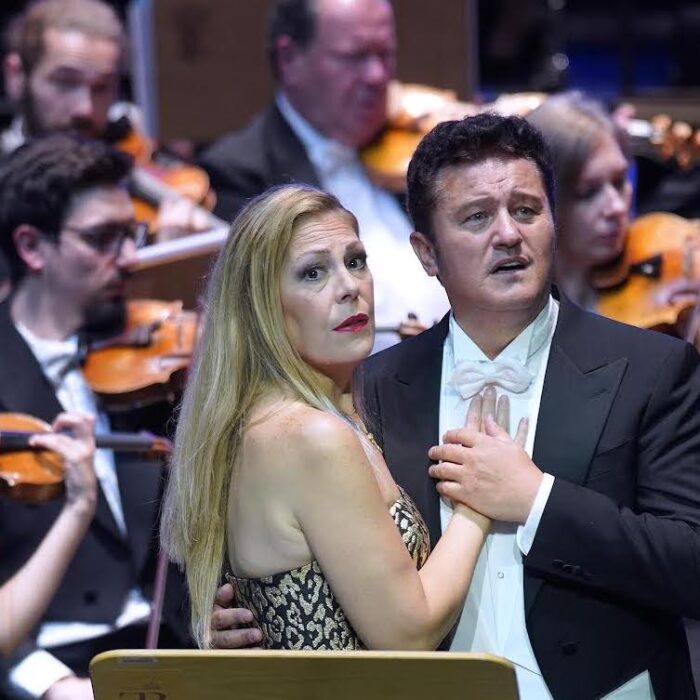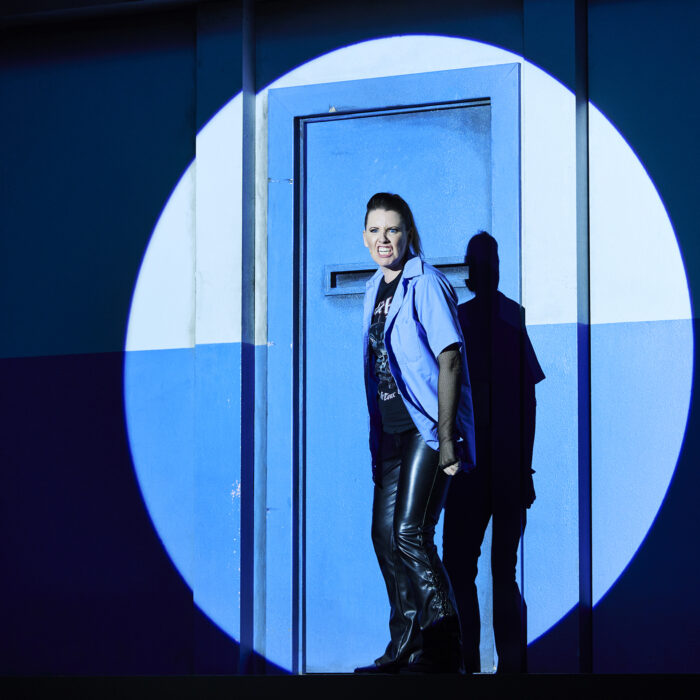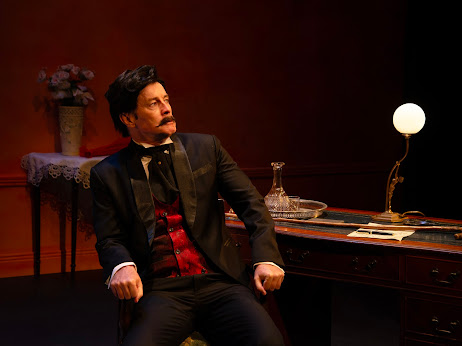
Deutsche Oper Berlin 2023-24 Review: Götterdämmerung
By Vincent Lombardo(Photo Credit: Bernd Uhlig)
There is something unique about waiting for the curtain to rise on “Götterdämmerung.” Anyone who has followed a “Ring” in the theatre, may take their seat in sadness as this evening will end the journey through the most fabled, mythical and symbolic landscape of all. Though the images and sentiments confronted in any given production condition us as to what to expect at this point in the cycle, images of past Ring experiences will always return. One is isolated in time, and the nostalgia associated with a sense of illo tempore, Time immemorial. This is a visionary’s descent into the worlds above and below.
Illuminating Production
The Prelude leads into the Prologue, wherein the three Norns are weaving the rope of destiny. Two impressive chords in E flat minor and C major clash, and are reminiscent of the moment of Brünnhilde’s awakening. Yet, here we are in the foyer of the Deutsche Oper Berlin with the immigrants now dressed Yuppie-like, as though at a party in a Woody Allen film. They come out of the frozen tableaux, only to glide to the ground as the blindfolded Norns enter, grasping out into empty space. The fallen immigrants reach out to them; and yes, hand in hand, they assume the character of destiny’s rope itself. Yet, undulating as they did in the “Das Rheingold” prelude, ever sensitive to the sway of the music. They mime the death of “The Tree of Life”, but not to great effect. The Norns are absorbed in the foyer, and as they sing of the eventual logs cut from the Ash, the immigrants stand, stripping down again to underwear, then waving their hands as fluttering flames devouring Valhalla to the Fate motif. Suitcase walls roll in, with the pianoforte, Siegfried and Brünnhilde sleeping to Loge’s fiery flame music. But, no! When a Norn sings of Alberich, an immigrant pops out of the mass, wearing Alberich’s Joker mask.
In the second scene of the Prologue, Brünnhilde dresses Siegfried as she was on the fire rock, with an armor plate, Valkyrie helmet, shield. and she kisses him – a reversal of roles, so to say. He stands as a valiant knight, and to the hearty applause of the migrants. One might say this truly destroys the dramatic power of Wagner’s action and music. It seems to go nowhere, and being the last opera in the cycle, it does weigh heavily now. Unless, that is, one feels that this is necessary to make all seem more interesting and easier to follow, in an instructive way.
A crafty scene change happens as the pianoforte in centre stage with Brünnhilde playing, glides into the wings; another pianoforte arrives to stage right. Hagen is seated and playing a sprightly, full-throated version of the “Nature” motif that opened “Das Rheingold”, while Hagen wraps himself in a piece of silk blown across the stage. Alberich and his son Hagen stare across the pianoforte, and Gunter and Gutrune, Gibichung half-brother and sister drink one of the 3,000 glasses of wine in the hall. Here, through their dialogue, the plot thickens. A family of weaklings in modern dress, but characteristic of all bourgeois social climbers.
Gunther will never break through the fire to get to Brünnhilde, in order to marry her and take possession of the ring. Gutrune feels too insecure to attract Siegfried. Hagen promised Alberich to get the ring. This scene has the advantage of allowing the singers to tell their tales simply, especially so as all is intertwined and complicated.
Siegfried arrives, and it is touching to see him growing into a man. Herheim, when humorous, is always able to play around with us. Gunther gives Siegfried his calling card, which is promptly thrown away in a gesture of “I couldn’t care less.” The acting and staging of the “Gibichung” is very good, as they watch Siegfried under the influence of the potion, Hagen guiding them. But then, the long piece of silk becomes over-used: flames, bridal gown, and so on. Gunther and Siegfried swear the blood oath, but only after stripping down into their underwear.
Off they go, and Hagen covers the pianoforte with the white sheet, then uses it to cover Gutrune as if it were a bridal gown. One recalls Erda in Chereau’s Bayreuth centennial production. The plot hatched to procure Brünnhilde for Gunther, and Siegfreid for Gutrune is set in motion to procure the Ring and all its power for Hagen, who has this as his obsessive motivation. “Hagen’s Watch” is as profoundly dramatic as one could wish for. As usual, there is little movement. Hagen sits on a chair, alone and in thought. Alberich is seen in the shadows, motionless and glaring, unobserved, listening in on his stepson’s evil proclamations. Chillingly, Alberich wipes grease paint off his Joker makeup, and smears Hagen’s face just before he walks off the stage, breaking the fourth wall to sit in the front row in the theatre, where we find Waltraute. She gives up her seat to go to Brünnhilde. All of this makes an insteresting feast, but ignores Wagner’s desire for us to participate in the stage action without interference from a distance, across a mystic gulf.
Highs & Lows
“Listen and reflect on what I now tell you,” Waltraute whispers. The “Ring’s” third great monologue is dramatic and emotional. Herheim creates perhaps the best scene of all in this production as to grandeur, pictorial eloquence: high above us, Valhalla, with an aging Wotan (a sort of withered Don Quixote) seated pathetically upon his throne, surrounded by his ghost-like court. Waltraute’s words are enriched by a vision of that distant castle. No one moves, and indeed it seems as if we were before a grand 18th century painting in the Louvre, illuminated with light and shadow as in Caravaggio’s almost theatrical lighting. It is a majestic image in every sense of the word, as seen through Waltraute’s eyes. Here, the text is felt in all its eloquence: “Both his ravens he sent on their travels; if ever they come back again with good tidings, then once again – for one last time – the God would smile forever.” The Gods surrounding him stir, and we are moved through sublime music, creating a bouquet, a breath of emotional song.
The second Act plays out with only the greatest of players left to survive, finding a complicated combination of moves, yet making mistakes. Also, there is destiny involved, as things may go their own way. And as in chess, there seems to be a sense of justice in one’s victory, yet with the winner admitting that changes came about mysteriously, almost out of their control. Chess is a symbol of the dramatic intricacies of life, as we are left to discover in “Götterdämmerung”.
All begins with another pantomime somewhat removed from Wagner’s scheme. It is storytelling as related to the music, yet again the music could suffice. Instead of Alberich alone with his son Hagen on stage, we also find a sleeping Siegfried, ring on his finger. Alberich tugs away at removing it, but Siegfried lies immovable. But why this scene? We know of Alberich’s crazed desire to possess the ring, and we have by now understood the character psychologically. Every animated cartoon gesture attempts to attach itself to music of great impact, followed by insisting tension within violins in rising scales. As a symbol of inner stress and his inability to regain his power, he sits at the pianoforte, fights sleep, only to slumber off, his head banging onto the keyboard as dissonant chords shriek. All this demonstrates the major weakness of this staging; an attempt to read into Wagner’s psychological intuitions when painting characters or episodes tonally in his Vorspiele through ulterior ramifications, adding little to what he have already understood.
The third and final Act of all the “Ring” is a letdown. In the first scene, the Rhine Maidens move restlessly beneath a strip of white sheet, which they hold in their hands for the entire scene, limiting all freedom of movement. The second scene is set in the Deutsche Oper foyer, with Siegfried in the woods, waving the sheet in hand as he sings of waterfowl. Hagen’s hunting party arrives at the opera. As Hagen attempts to remove the ring, Siegfried raises his arm in a somnambulistic gesture. This is a mysterious moment perhaps explained if we imagine that he is aware in a dream that he will soon die by Hagen’s spear. The Trauermarsch is poorly handled; it becomes Hagen’s böser Walzertanz. Gunter’s melodramatic scream over Siegfried’s dying body is anti-climatic, taking from the sense of pain and tragedy already established. Also exaggerated is Hagen’s decapitating Siegfried, usually a gesture to represent hatred, or it can be a ritual to eliminate the pain of a dying man in the Japanese sense. Worse yet, the head gets passed around to Gunther and Brünnhilde, the image lingering as the head is placed next to Siegfried’s body, staring out to us. This disturbing image was seen in the Valentin Schwarz production at Bayreuth a few years back. A nice touch it is to have Wotan sit on the piano stool. Brünnhilde, the daughter, removes his helmet, and in a simple, most touching gesture covers his one seeing eye, as if to say, “Rest in peace, smile forever.” The final vision we have is the immigrants undressing, soon to be become a mass of flame, arms raised, fingers vibrating. Brünnhilde light the logs with the spear tip. The immigrants circle her and the pianoforte, and beneath red-light they flicker to the destruction of Valhalla.
Illuminating Cast & Orchestra
Clay Hilley closes out as Siegfried on a high note. The voice throughout the cycle was faithful to every note, and the energy never waned. His is a that of a heldentenor. His stage presence was commendable, and all the nuances of the role as sketched out by Herheim were carried out with brio, combining self-irony with tragedy.
The Brünnhilde of Ricarda Merbeth never let us down, and our sympathies poured out to her. Her vocal energy carried her through “Der Ring,” her subtle intuition remarkable.
The Gibichung family of Hagen (Albert Pensendorfer), Gunther (Thomas Lehman) and Gudrune (Felicia Moore) were a unified clan, especially so as Herheim left them basically alone, faithful to their emotions. Each voice was tailor-made for the role.
Waltraute, interpreted by Annika Schlicht, was stupendous, subtlety of voice and acting; the fact that the music is moving, elegant and the staging pure-and-simple made this a memorable scene.
The Rhine Maidens (Lea-Ann Dunbar, Karis Tucker and Lindsay Ammann) and the Norns (Lindsay Ammann, Karis Tucker, and Felicia Moore) were all fine, but suffered by the characterizations heaped upon them by Herheim.
Maestro Runnicles did indeed bring us a memorable Ring musically, and not just for the music. There were many moments in his diverse reading of the score that suggested his desire to unite the orchestra with the singers. At Bayreuth, there is a unique acoustic that mixes voice and orchestra, bringing the sound to us as a united force. In Berlin, the sound blended all as though in a symphony. The overall impression was one of a slightly French tradition, the winds expressive, the horns subtle, and brass subdued when necessary, and the strings shimmering, agitated, soothing. At the end of the cycle, the entire orchestra appeared on stage for the final round of curtain calls and Maestro Runnicles asked the First horn to stepforward, recognizing his mellifluous, poignant playing throughout.
In Conclusion
As to a stage director’s main challenge of mounting “Der Ring”, one must find a single idea upon which to base all the subsequent action, remaining consistent to the end, and always faithful to Wagner, in conjunction with the scenic elements, the costumes which establish a historical era, or not. The costumes in this production emulated the original 19th century representations. The scenery was at times fascinating, the suitcases piled as mountains and walls, but they did wear on some of us visibly over the span of the tetralogy.
Regarding the entire “Ring,” Herheim tells us: “I can see that this game of staging is so diffuse, and so open- ended that you have really no chance of succeeding if, based on common sense, you choose a single perspective that allows you to see the whole thing as a coherent construct. No one was more conscious of this than Wagner.” And this is the point. This “Ring” is based on a single perspective, a clear attempt at capturing that spirit of our age, a ghost among us, our Zeitgeist.
The “Ring” experience is an extremely personal one, with attention given to Wagner’s score. One must dedicate their soul and mind to him while listening to the music, and he will enrich you. As would ancient runes, the tetralogy creates linguistic perplexities, proposing secretive, esoteric knowledge, and that of the earth buried just below us. We must be aware of this, and seek it out again and again. As a symbol, the “Ring” appears above all as an eternal circle, constant as a wedding band, faithful as our solar system to its Sun, as something unique and ever rewarding, ever mysterious.
In the end, it remains a force of nature rattling and rolling above and below us – if nothing else, bringing us closer to that part of ourselves, that magnificent testimony to this struggle called life.



